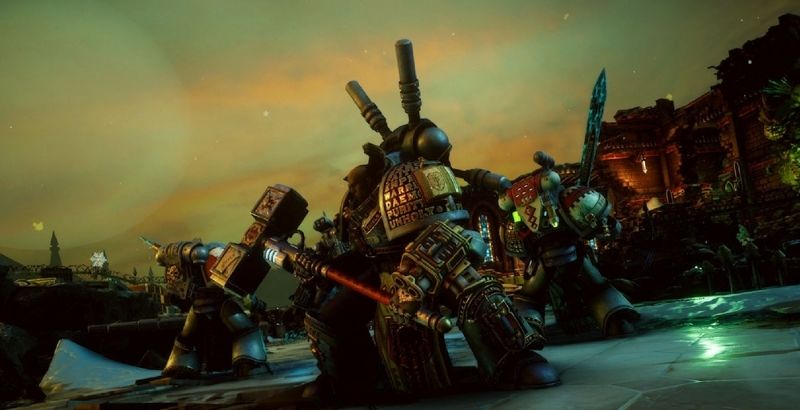
As part of this year’s GDC, I was lucky enough to get some hands-on time with the upcoming squad-based tactical game Warhammer 40,000: Chaos Gate – Daemonhunters from the developers at Complex Games.
My time with the game was split into four sections, two of which were regular missions, one of which was a boss fight, and the last was a cutscene. At the start of each mission, I was able to get a brief glimpse at the player’s ship and home base throughout the game, The Bleful Edict. It is in that ship that players can interact with NPCs, upgrade and customize their soldiers, travel throughout its star system, and research new technologies. I was unable to interact with any of these systems during my time with the game, but from what I saw, the ship’s design perfectly encapsulates what so many fans love about 40k‘s iconic Space Marines.
The first mission I embarked on had me taking a squad of four marines to extract seeds of the Bloom, a parasitic growth quickly overtaking the star system, from living hosts that work in service of Nurgle. To do this, I have to get one of my marines with melee capabilities up close and personal with one of the targets to perform a special melee attack. But first, I’m ambushed by a squad of soldiers infected by Nurgle’s rot. This is my first introduction to the game’s combat. Each marine in the squad has a different class that grants them unique abilities, from a melee sword that can teleport behind enemies to having a bot that can heal other marines.
It is easy to draw comparisons between Daemonhunters and the genre juggernaut of XCOM 2, but the developers have done an admirable job putting a Warhammer 40,000: Chaos Gate spin on it. It does so by making its Space Marines feel like the powerful warriors they are.
This is done by throwing handfuls of enemies at your squad of only four marines that you can take out with relative ease. Staying in the cover is not as big of a focus in the strategy of Daemonhunters as it is in many other games in the genre, allowing you to make bolder moves like running a marine right up to a group of enemies and leaving them there after a melee attack.
From my time with the game, it seemed to change the strategic focus from playing conservatively and avoiding damage at all costs to properly managing your resources for multiple encounters in one mission. This change in prioritization also meant that often times the best way to get through an encounter was to be as aggressive as possible to get through it with minimal enemy turns.
With that approach, my squad made short work of the first mission. We walked through three squads of enemies like they were nothing, dealt with the random events that popped up as we went, and soon closed in on an enemy with a Bloom Seed. Then, it was just a matter of getting a melee character in and ensuring they got a critical hit to take advantage of their special targeting.
This special targeting mode allows you to focus on different parts of the enemy, each with unique impacts. These can include cutting an arm to lower their accuracy, damaging a leg to slow their movement, or even hitting their head for double damage. In this case, however, I had to take the Bloom Seed off them, and then I was ready for my second mission.

The second mission took me to a dense industrial world that was just starting to be subject to Bloom spread. I tracked it down to a large warehouse with two entrances, so I split my squad in half and sent two to each door to ensure I wouldn’t get flanked. However, the enemies had much stronger firepower on this mission, forcing me to consolidate my forces.
This mission made it abundantly clear to me that, at least on its standard difficulty, Daemonhunters gives players the ability to react and fix their strategy when things don’t go their way. I’m sure higher difficulties will be more punishing, but it was great not to have one poor tactical decision wipe out half of my squad.
The rest of the mission went smoothly, and I moved on to the preview’s boss encounter. It featured a massive creature named Aeger, The Benevolent. He towered over my squad, a twisted version of a Cat of Nine Tails in one hand and a bell in the other, while intestines poured out of an open wound spanning his stomach.
For the boss fight, I was given a new unit type that had a flamethrower, which proved to be critical to my success. The battlefield was awash with rivers of bile and had nests scattered around its outer perimeter. Nurglings would come out of those nests, as well as the open wound in Aeger’s stomach, that he could consume for certain abilities or attack my squad members.
The boss fight was difficult, but it never felt overwhelming or like things were hopeless. The scale of the boss and the unique mechanics helped make the entire fight a wonderful spectacle, but once I took out the nests, I focused on Aeger himself, and he eventually fell to the might of the Space Marines.
For my troubles, I was rewarded with a cutscene showing what the Space Marines do when a planet is considered a lost cause. The answer is simple; they get rid of it. The cutscene wasn’t in a finished state but gave a good hint at what fans can expect from the more cinematic elements of Daemonhunters, and it looked as though the game will give 40k all the grandeur and excitement it deserves.
Warhammer 40,000: Chaos Gate – Daemonhunters releases on May 5 for PC.






